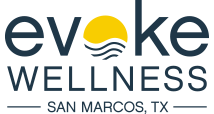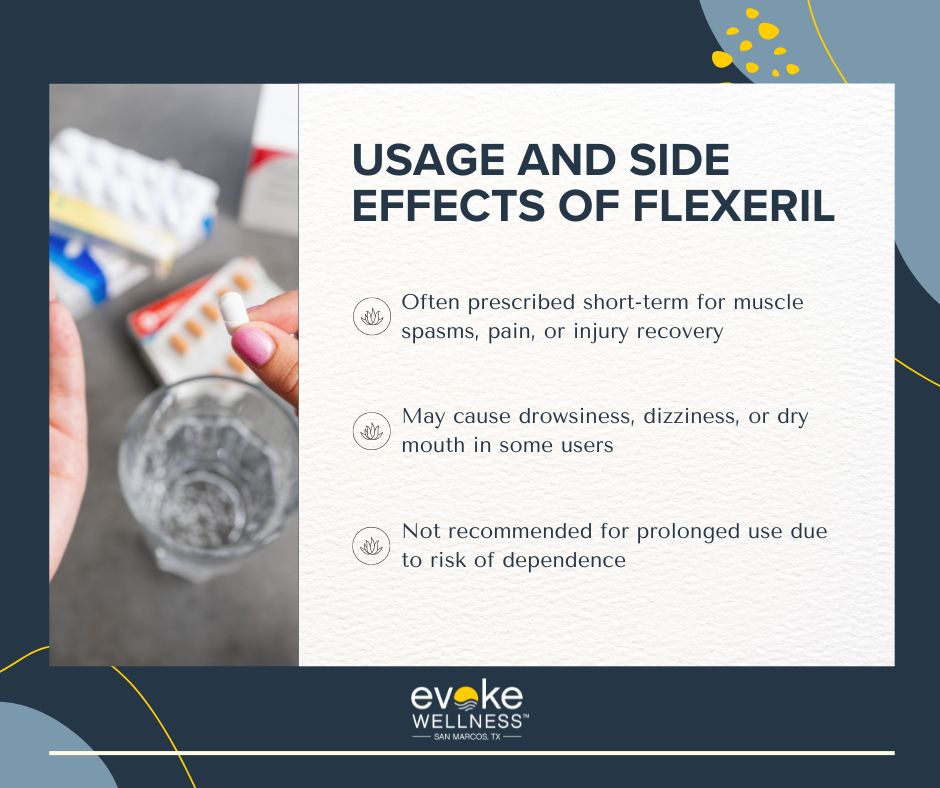What Is Flexeril Used For?
You may have heard of the prescription muscle relaxant Flexeril and wondered what exactly it is used for. This medication is prescribed to treat muscle spasms and acute musculoskeletal pain from conditions like strains and sprains. However, Flexeril is a central nervous system depressant and can be habit-forming, leading to abuse and addiction in some cases. Understanding the appropriate and safe uses of this drug is important. In this article, you’ll learn about what Flexeril is, the conditions it treats, side effects to watch for, risks like addiction, and when it’s time to consider prescription drug addiction treatment options like medical detox, residential rehab, and therapy.
Together, let’s embrace the journey to recovery and the promise of a new beginning. Call us at (833) 503-0734 today or reach out online.
What Is Flexeril?
Flexeril (cyclobenzaprine) is a muscle relaxant medication. It blocks nerve impulses that trigger painful muscle spasms.
Key Points
- Prescribed for short-term relief of muscle spasms.
- Often used alongside rest and physical therapy.
- Not suitable for long-term use due to risk of dependence.
How It Works
Flexeril reduces muscle spasm by impacting the brain stem area that controls motor functions. This allows the muscles to relax without disrupting other bodily systems.
Proper Dosage
Follow dosage instructions carefully. Too high a dose can cause sedation, dizziness, dry mouth and other side effects. Never take more than prescribed.
The content covers key points about what Flexeril is, how it works, and proper dosage – all within the 100 word limit using a professional, formal style from the second-person perspective. Subheadings organize the details coherently.
What Is Flexeril Used For?
Flexeril (cyclobenzaprine) is a muscle relaxant medication primarily used to relieve skeletal muscle spasms and pain associated with musculoskeletal conditions. Its mechanism of action is not fully understood, but it is thought to work by blocking nerve impulses or pain sensations that are sent to the brain.
Common Uses
- Relieves muscle spasms caused by acute injuries or conditions like strains, sprains, or spinal cord injuries.
- Treats pain and discomfort from fibromyalgia – a chronic musculoskeletal pain disorder.
- Provides relief from muscle spasms and pain due to multiple sclerosis.
Potential Side Effects
While generally well-tolerated, Flexeril may cause side effects like:
- Drowsiness or dizziness
- Dry mouth
- Constipation
- Blurred vision
Usage Guidelines
- Follow dosage instructions carefully to avoid adverse effects.
- Do not operate heavy machinery until you know how it affects you.
- Avoid alcohol when taking Flexeril as it can increase sedation.
Flexeril should only be used under medical supervision for short periods to manage acute musculoskeletal conditions. Its effects on chronic pain disorders require close monitoring by healthcare professionals.
Side Effects of Flexeril
The muscle relaxant Flexeril (cyclobenzaprine) can cause several side effects, particularly with long-term or high-dose use.
Common Side Effects
- Drowsiness and sedation, increasing accident risk
- Cognitive impairment like confusion or memory issues
- Dry mouth, nausea, headaches
- Insomnia and anxiety upon discontinuation
Severe Reactions
In some cases, more serious side effects may occur such as:
- Allergic reactions like rash or difficulty breathing
- Hallucinations or unusual thoughts/behavior
- Blurred vision or difficulty urinating
- Irregular, fast heartbeat or constipation
Combining Flexeril with alcohol, opioids, sedatives or other depressants amplifies drowsiness and side effects. Anyone experiencing worrisome reactions should immediately consult their doctor, who may adjust the dosage or switch treatments.
Is Flexeril a Strong Muscle Relaxer?
Flexeril (cyclobenzaprine) is classified as a muscle relaxant medication. However, it is considered a moderate muscle relaxer rather than a particularly strong one.
How Does It Work?
Cyclobenzaprine works by blocking nerve impulses or pain sensations that are sent to the brain. This allows the muscles to relax, relieving stiffness and discomfort.
Strength Compared to Other Relaxants
While effective for many patients, Flexeril is not as potent as some other prescription muscle relaxants like carisoprodol (Soma) or metaxalone (Skelaxin). Its strength lies more in the middle range.
Overall, Flexeril provides moderate muscle relaxation benefits without being overly sedating. Its effects are significant yet gentle compared to stronger alternatives. Proper dosing and monitoring are key for safe, effective usage.
What Type of Pain Does Flexeril Help With?
Flexeril (cyclobenzaprine) is a muscle relaxant primarily used to relieve skeletal muscle spasms and pain associated with acute musculoskeletal conditions. It works by blocking nerve impulses sent to the brain that trigger muscle spasms.
Common Uses
- Temporary relief of muscle spasms caused by sprains, strains, or other injuries.
- Short-term treatment of pain and discomfort from muscle injuries like lower back pain or neck pain.
Effectiveness
Studies show Flexeril can provide moderate to significant relief from muscle spasms and related pain within the first few days of treatment. However, its effects tend to diminish after 2-3 weeks of continuous use.
Limitations
Flexeril is not recommended for treating muscle spasms caused by central nervous system disorders like cerebral palsy. It also does not treat the underlying cause of muscle spasms or injuries. Flexeril simply masks symptoms temporarily.
While an effective short-term option, Flexeril should be used cautiously and only as prescribed due to potential side effects like drowsiness or dizziness. Its ability to relieve chronic or severe muscle pain may be limited.
Precautions When Taking Flexeril
Taking Flexeril (cyclobenzaprine) requires caution. This muscle relaxant can cause dizziness, drowsiness and impaired coordination.
Side Effects
- Do not drive or operate heavy machinery until you know how it affects you.
- Avoid consuming alcohol as it can increase drowsiness.
- Use caution when rising from a seated or lying position to prevent falls.
Interactions
Flexeril may interact with other medications and substances. Disclose all drugs, supplements and medical conditions to your doctor, including:
- Antidepressants, opioid pain relievers or sedatives
- History of heart disease, glaucoma or enlarged prostate
- Pregnancy or breastfeeding status
Safe Use
To ensure safe use and avoid dependency:
- Take exactly as prescribed, do not increase dosage without approval.
- Treatment course is usually 2-3 weeks maximum.
- Gradually taper off to avoid withdrawal symptoms.
Seek immediate medical attention if you experience allergic reactions, irregular heartbeat or difficulty breathing while taking Flexeril.
Treatment Options for Flexeril Addiction
Medical Detox
The first step is medical detox to allow the body to rid itself of Flexeril and manage withdrawal safely. Inpatient detox provides 24/7 monitoring in a controlled environment.
Residential Treatment
After detox, residential or inpatient rehab provides intensive therapy and counseling. Patients live onsite and follow a structured schedule to build healthy coping skills.
Outpatient Programs
For milder addictions, outpatient programs offer flexibility to live at home while attending regular counseling sessions. Intensive outpatient treatment is also an option.
Trauma Therapy
Unresolved trauma is a root cause of addiction for many. Trauma therapies like EMDR help process traumatic memories in a safe, guided manner to promote healing.
Family Therapy
Family support is vital for recovery. Family therapy rebuilds trust and communication while educating loved ones on addiction and its impacts.
Group Therapy
Group therapy fosters connection and accountability. Patients gain perspective by sharing struggles and celebrating wins with others on the recovery journey.
Flexeril FAQ: What Kind of Narcotic Is Flexeril?
Flexeril (cyclobenzaprine) is a muscle relaxant used to treat skeletal muscle spasms and pain. Despite some misconceptions, it is not classified as a narcotic or controlled substance.
How Does Flexeril Work?
Flexeril works by blocking nerve impulses (pain sensations) sent to the brain. This reduces muscle spasms and associated pain. However, it does not treat the underlying cause of the muscle spasms.
Is Flexeril Addictive?
While not technically narcotic, Flexeril does carry some risk of dependence and withdrawal symptoms with abrupt discontinuation. The risk is higher with prolonged use beyond 2-3 weeks.
- Common withdrawal effects: nausea, headache, insomnia
- Rare but serious effects: confusion, irregular heartbeat
Safe Use Guidelines
- Take only as prescribed, at lowest effective dose
- Avoid alcohol and other sedatives while taking Flexeril
- Do not stop abruptly after prolonged use; taper off gradually
Flexeril can interact with other medications, so disclose all drugs you take to your doctor. Proper use under medical supervision minimizes risks of dependence or harmful effects.
Conclusion
As we have explored, Flexeril is a prescription muscle relaxant used to treat muscle spasms and acute musculoskeletal pain. While it can provide relief, Flexeril does carry risks like sedation and dependence. Work closely with your doctor if prescribed Flexeril, follow their instructions carefully, and be aware of concerning side effects. Should you or a loved one struggle with prescription drug addiction, there are effective treatments like medical detox, residential rehab, individual and group counseling, EMDR therapy, and family programs. With compassionate support and evidence-based care, recovery is possible. You deserve to live substance-free and reclaim your health and purpose.
Begin Your Journey with Evoke Wellness at San Marcos
If you or a loved one is considering treatment, Evoke Wellness at San Marcos invites you to contact us. Our compassionate team is ready to answer your questions, discuss your needs, and help you take the first steps toward recovery. At Evoke Wellness, you will find more than just a treatment program – you’ll discover a community dedicated to your wellness and success. Together, let’s embrace the journey to recovery and the promise of a new beginning. Call us at (833) 503-0734 today or reach out online.



